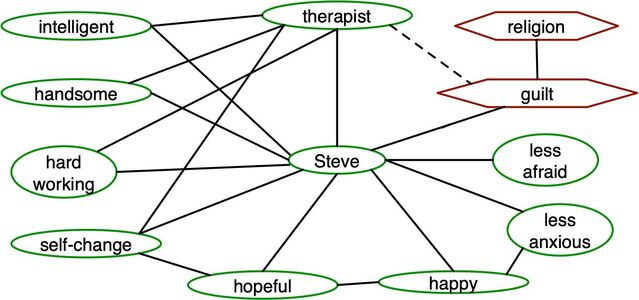Embarrassment
Mapping Emotional Change in Psychotherapy
How do psychotherapists help clients to reduce negative emotions?
Posted July 28, 2020
People go to psychotherapists in search of emotional change because they are afflicted with negative emotions such as sadness, anxiety, anger, and low self-esteem. Effective therapists can help them to recover from these emotions and experience positive feelings such as happiness, confidence, hope, serenity, and pride. Such important changes can be charted using the technique of cognitive-affective mapping that has served to describe and explain numerous cases of social change.
Systems of emotional values can be conveniently displayed using a diagramming technique that produces a cognitive-affective map (CAM), also called a value map. Concept maps have been commonly used since the 1970s but they do not depict the values or emotions associated with concepts. This technique employs the following conventions:
- Green ovals represent emotionally positive (pleasurable) elements.
- Red hexagons represent emotionally negative (painful) elements.
- Rectangles represent elements that are neutral or carry both positive and negative aspects.
- Solid lines represent the relations between elements that are mutually supportive.
- Dashed lines represent the relations between elements that are incompatible with each other.
Here are is a case of emotional change in psychotherapy modified to maintain anonymity. The technique of cognitive-affective mapping depicts the mental state of a client before, during, and after therapy.
Steve is a man in his 20s who suffered sexual abuse as an adolescent that induced prolonged negative emotions including shame, embarrassment, disgust, bitterness, and helplessness. Therapy helped him to experience less shame and increased frequency of positive emotions such as happiness and hope. Figure 1 shows some of the key concepts and emotions in Steve’s mental state at the beginning of his therapy session. One technique used is gauging the emotional state of clients by asking them to circle their current emotions from a list of around 40 typical emotion words such as “afraid” and “sad.” Questioning the client provides initial information about the causes of those emotions. Figure 1 shows a cluster of negative self-concepts arising from Steve’s sexual abuse that led to him thinking of himself as a helpless victim who had been betrayed. The resulting emotions include shame, embarrassment, and disgust. These interlinked negative concepts and emotions are represented by hexagons. The one oval positive element in Figure 1 is the therapist who is marked as opposed to helplessness by the dotted line.

As therapy progresses, the therapist helps Steve to develop the more positive configuration of values shown in Figure 2. Steve realizes the possibility of self-change including thinking of himself as intelligent, hardworking, and good looking rather than as a helpless victim. Negative emotions such as embarrassment and guilt are inappropriate because he did nothing wrong and ongoing guilt reflects only his religious background. Steve feels less anxiety and has the beginnings of hope and happiness. The connections of the self-concept and emotions with the therapist fits with the finding that the existence of a strong alliance between the client and therapist is one of the major predictors of successful therapy.

What brings about the shift from the negative emotions in Figure 1 to the mostly positive configuration in Figure 2? Psychotherapists can help to shift the emotional coherence of a client’s mental representation using the following steps:
1. Introduce new representations and connections such as Steve thinking of himself as intelligent.
2. Introduce representations of the therapist as allied with the client in generating positive emotions.
3. Encourage the client to see and feel that the new network of representations and connections is more coherent than the old one that generated distress.
For the full version of this post, see Thagard and Larocque (2020). See here for additional applications of cognitive-affective maps.


